Navajo Sterling Silver Box with Rainbow Man by Little Joe Begay - C3753.40
CG Wallace came to Zuni in 1919 at the age of 21. Over the next 50 years he was decidedly the most influential trader of Zuni and Navajo jewelry. He supplied the highest quality materials to his artists and demanded perfection. In 1975 he decided to give part of his personal collection to the Heard Museum and the remainder was sold at a Sotheby's auction. One of his silversmiths was a Navajo named Little Joe Begay who was active in the 1940s.
Read more about this jewelry here.
Pair of Small Zia Pueblo Paintings by MaPeWi - C3754C
Crescencio Martinez of San Ildefonso was the earliest of the pueblo easel artists. He passed away in 1918, long before pueblo easel art was recognized as existing. He was followed by four pueblo young men who essentially constitute the first artists to produce paintings to be sold. The four were Crescencio's nephew, Awa Tsireh, Hopi artists Fred Kabotie and Otis Polelonema, and Zia Pueblo artist Velino Herrera, Ma Pe Wi. They became very productive in 1918, feeding off each other's enthusiasm.
Read more about these paintings here.
Laguna Pueblo Contemporary Black-on-white Design Jar by Evelyn Cheromiah - C3752E
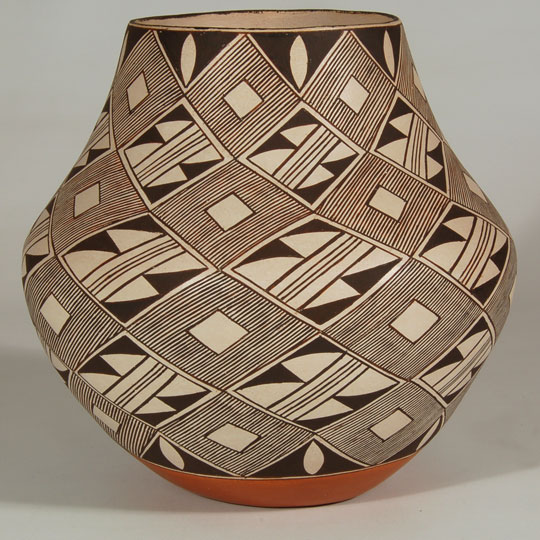 Pottery production declined at Laguna Pueblo in the early 20th century, largely because the men were being employed by the railroad, thereby providing cash income for the families. It was then no longer necessary for the women to make pottery for sale to tourists. They could, and did, purchase pottery from potters at Acoma Pueblo for use in their households.
Pottery production declined at Laguna Pueblo in the early 20th century, largely because the men were being employed by the railroad, thereby providing cash income for the families. It was then no longer necessary for the women to make pottery for sale to tourists. They could, and did, purchase pottery from potters at Acoma Pueblo for use in their households.
Read more about this pottery here.
Polished Black Oval Dish with Twisted Handles by Legoria Tafoya - C3752F
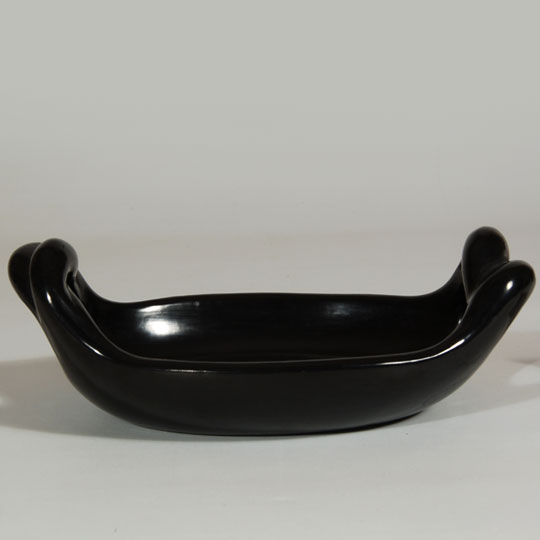 This beautifully polished black dish by Legoria features twisted handles often seen in Santa Clara engagement jars. Legoria used such handles in many of her pottery items where handles were incorporated and on wedding vessels between the two spouts. The dish is signed Legoria Str Clara Pueblo on the underside.
This beautifully polished black dish by Legoria features twisted handles often seen in Santa Clara engagement jars. Legoria used such handles in many of her pottery items where handles were incorporated and on wedding vessels between the two spouts. The dish is signed Legoria Str Clara Pueblo on the underside.
Read more about this pottery here.
San Ildefonso Stone Polished and Carved Red Jar by Rose Gonzales - C3752D
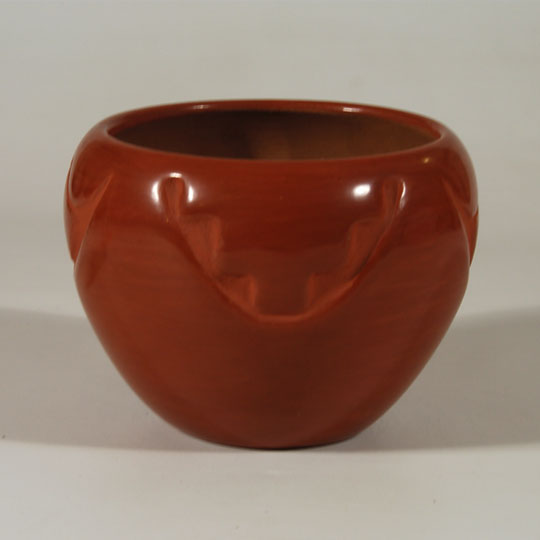 Rose Gonzales was born at Ohkay Owingeh (formerly San Juan) Pueblo in 1900 and, soon after, became an orphan when her parents died from the flu epidemic. She and her sister survived by boarding at the Santa Fe Indian School. She married Robert Gonzales of San Ildefonso Pueblo and moved to his pueblo at that time. She learned the art of pottery making from his mother.
Rose Gonzales was born at Ohkay Owingeh (formerly San Juan) Pueblo in 1900 and, soon after, became an orphan when her parents died from the flu epidemic. She and her sister survived by boarding at the Santa Fe Indian School. She married Robert Gonzales of San Ildefonso Pueblo and moved to his pueblo at that time. She learned the art of pottery making from his mother.
Read more about this pottery here.
Kewa Pueblo Silver and Turquoise Ring by Anthony Lovato - C3750Q
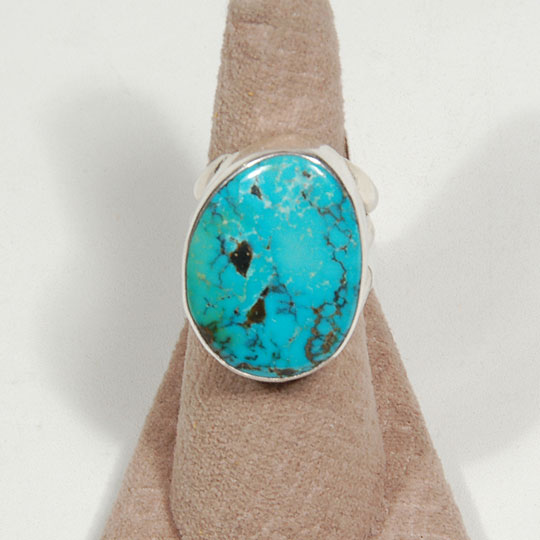 Anthony Lovato is Corn Clan from Kewa Pueblo. He has been an active jeweler since he was 20 years old. He studied at the Institute of American Indian Arts (IAIA) in Santa Fe and studied under the tutelage of Allan Houser. He also credits Leo Coriz, Sedelio Lovato and Skip Holbrook as teachers.
Anthony Lovato is Corn Clan from Kewa Pueblo. He has been an active jeweler since he was 20 years old. He studied at the Institute of American Indian Arts (IAIA) in Santa Fe and studied under the tutelage of Allan Houser. He also credits Leo Coriz, Sedelio Lovato and Skip Holbrook as teachers.
Read more about this ring here.
Zuni Petit Point Drop Clip Earrings - C3750N
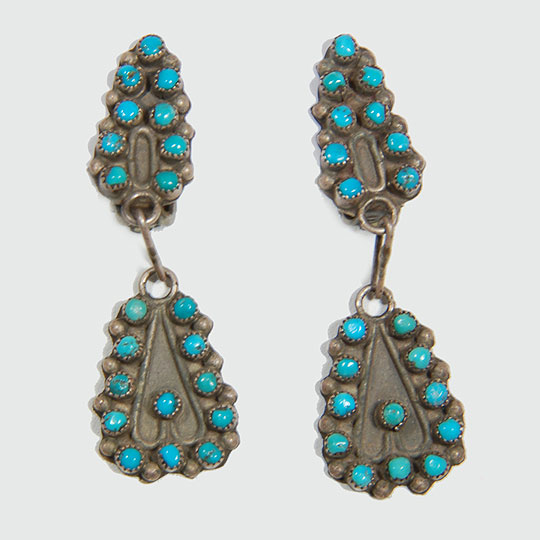 Zuni artisans have a long history in lapidary work but after learning silver work from the Navajo in the late 1800s, they put the two ideas together and started producing jewelry of silver and stone. Zuni lapidary artisans became proficient in mosaic-style inlay jewelry and miniature turquoise stones called petit point. Zuni petit point jewelry was first made in the 1930s. This process is time consuming and painstaking. Multiple small stones are cut and shaped to fit into tiny bezels to create the design.
Zuni artisans have a long history in lapidary work but after learning silver work from the Navajo in the late 1800s, they put the two ideas together and started producing jewelry of silver and stone. Zuni lapidary artisans became proficient in mosaic-style inlay jewelry and miniature turquoise stones called petit point. Zuni petit point jewelry was first made in the 1930s. This process is time consuming and painstaking. Multiple small stones are cut and shaped to fit into tiny bezels to create the design.
Read more about these earrings here.
Zuni Silver and Inlay Butterfly Necklace - C3750H
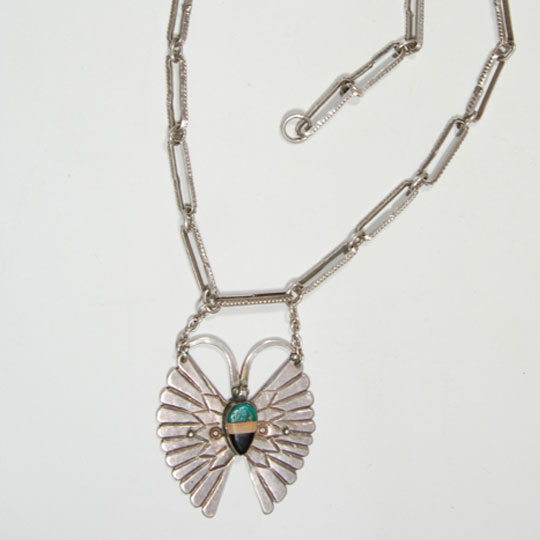 This exquisite sterling silver sculpted butterfly pin is not signed with the name of the artisan but it appears to be an early Zuni piece perhaps from the 1940s. The silver chain is handmade and each link in the chain is stamped with a design. It is quite possible that the butterfly was a pin at one time and has been converted to a necklace.
This exquisite sterling silver sculpted butterfly pin is not signed with the name of the artisan but it appears to be an early Zuni piece perhaps from the 1940s. The silver chain is handmade and each link in the chain is stamped with a design. It is quite possible that the butterfly was a pin at one time and has been converted to a necklace.
Read more about this necklace here.
Male and Female Pair of Butterfly Dancers by Alfonso Roybal - Awa Tsireh - C3749B
There were cross cultural experiences and influences between the early European-American artists of Santa Fe and Taos and the local Pueblo painters. Santa Fe artist William Penhollow Henderson, who moved to Santa Fe in 1916, had an influence on the work of Awa Tsireh in that Henderson shared his art books with Awa Tsireh and some of those books were on Japanese and other Asian arts.
It is quite likely that Awa Tsireh developed the style seen in this painting through studying Henderson's Asian art books. The static, frontal symmetrical positioning of flat imagery outlined in black line and filled with flat bright colors has a definite Asian appearance. The dancers are positioned facing to the front with their feet facing sideways. Their faces are rounded and abstract, yet their clothing is pictured in the finest accurate detail. It is this style that Awa Tsireh produced in the 1920s. This is only one style of Awa Tsireh's art. He apparently tried styles seen in other books belonging to Henderson.
Read more about this painting here.
Painting of a Navajo Encampment by Andrew Van Tsihnahjinnie - C3751
Tsihnahjinnie was a master at depicting a realistic approach to the everyday life activities of his people. Where as Harrison Begay portrayed an idealistic approach to Navajo life, Tsihnahjinnie was recording the history of the Navajo in his paintings. He painted scenes of Sings (a ceremony), Gamblers, Dances and other events of the isolated life of the Navajo.
Read more about this painting here.
San Ildefonso Antelope Dancer signed Awa Tsireh by Alfonso Roybal - C3749A
Alfonso Roybal (1898-1955) Awa Tsireh was painting before 1917 while he was still a teenager. He was the oldest of the early group of pueblo painters. His formal education had not extended beyond primary grades. He was versatile in his styles of painting in that he was equally comfortable with representational or semi-realistic. Most of his work is in the Santa Fe Indian School two-dimensional style, particularly his early work and many of those were single-figure images.
Read more about this painting here.
Taos Pueblo Painting of a Single Buffalo Dancer by Pop Chalee - C3142C
A book published in 1997 entitled "The World of Flower Blue" by Margaret Cesa provides a wonderful look into the life of Pop Chalee. Cesa states "Pop Chalee was one of the first Native American woman artists to achieve national fame, recognition and commercial success." The author continues to explore the artist, who was born of a Swiss mother and Taos Pueblo father, in 1906. Her father, Joe Lujan, was the brother of Tony Lujan who was the last husband of Mabel Dodge Lujan.
Merina Lujan - Pop Chalee (Blue Flower) graduated from the Santa Fe Indian School in 1937 and was a student at The Studio under the tutelage of Dorothy Dunn. The author continues: "Her paintings, jewelry, textile designs and murals grace museums, private collections and public institutions across the county. During her artistic life, Pop knew some of the most influential people of her times."
Read more about this painting here.
Black-on-Black San Ildefonso Jar signed Maria/Popovi 970 - C3752C
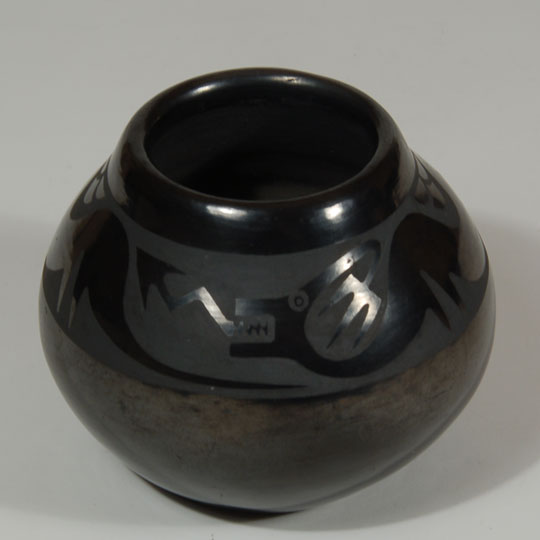 This small jar was made by Maria Martinez and painted, and probably fired, by Popovi Da. It features an Avanyu wrapped around the upper half of the jar, achieved by painting a matte border around the polished image desired.
This small jar was made by Maria Martinez and painted, and probably fired, by Popovi Da. It features an Avanyu wrapped around the upper half of the jar, achieved by painting a matte border around the polished image desired.
Read more about this pottery here.
Hopi Eagle Tail Design Jar in Polychrome by Fannie Polacca Nampeyo - C3752A
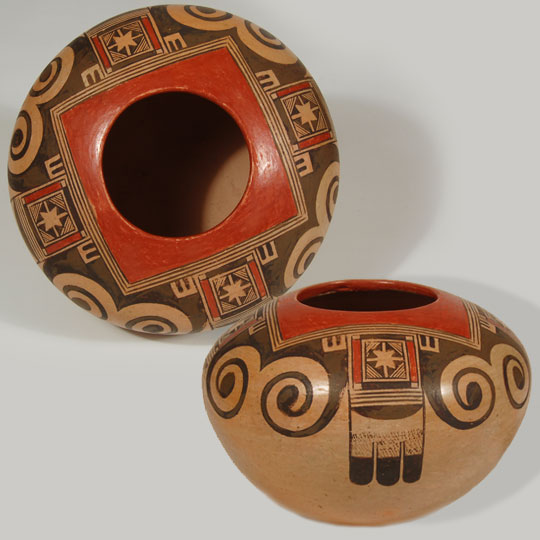 Fannie Nampeyo was an outstanding potter. She was one of three daughters of Nampeyo of Hano and was the last of the three to pass away. As a result, she is probably the best known of Nampeyo's daughters. Fannie was particularly adept at making fine, well balanced vessels. She seemed to be particularly outstanding at applying just the right design to fit the scale and shape of the vessel.
Fannie Nampeyo was an outstanding potter. She was one of three daughters of Nampeyo of Hano and was the last of the three to pass away. As a result, she is probably the best known of Nampeyo's daughters. Fannie was particularly adept at making fine, well balanced vessels. She seemed to be particularly outstanding at applying just the right design to fit the scale and shape of the vessel.
Read more about this Hopi Pottery here.
Santa Clara Pueblo Black Melon-ribbed Jar by Anita Suazo - C3752B
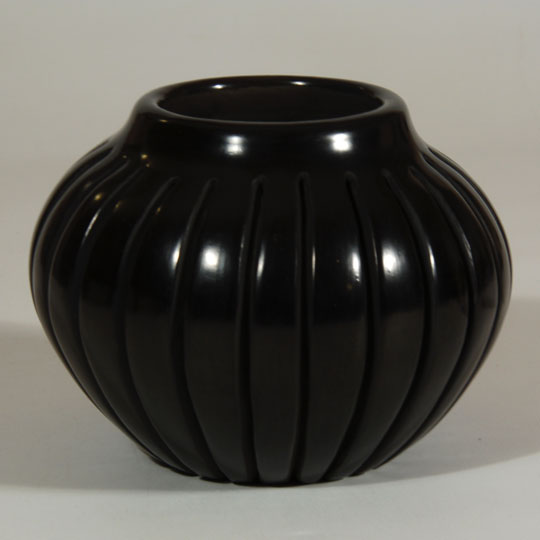 It is from the shape of melons that the pottery melon jar evolved. It resembles cantaloupe with its globular shape and vertical ribs. The melon jar seems to have developed at Santa Clara Pueblo with the most renown potters Helen Shupla and Angela Baca being the ones who specialized in making them. Other potters followed the tradition.
It is from the shape of melons that the pottery melon jar evolved. It resembles cantaloupe with its globular shape and vertical ribs. The melon jar seems to have developed at Santa Clara Pueblo with the most renown potters Helen Shupla and Angela Baca being the ones who specialized in making them. Other potters followed the tradition.
Read more about this pottery here.
Zuni Pueblo Channel Inlay Hummingbird Pin - C3750L
 Zuni lapidary artisans are masters at cutting turquoise precisely to fit between silver bars in a mosaic style. The shape of the pin has been noted as representing a pair of hummingbirds. The shape is known internationally and has many names but we will stick with the Zuni name.
Zuni lapidary artisans are masters at cutting turquoise precisely to fit between silver bars in a mosaic style. The shape of the pin has been noted as representing a pair of hummingbirds. The shape is known internationally and has many names but we will stick with the Zuni name.
Read more about this pin here.
Zuni Jet and Turquoise Adjustable Ring - C3750R
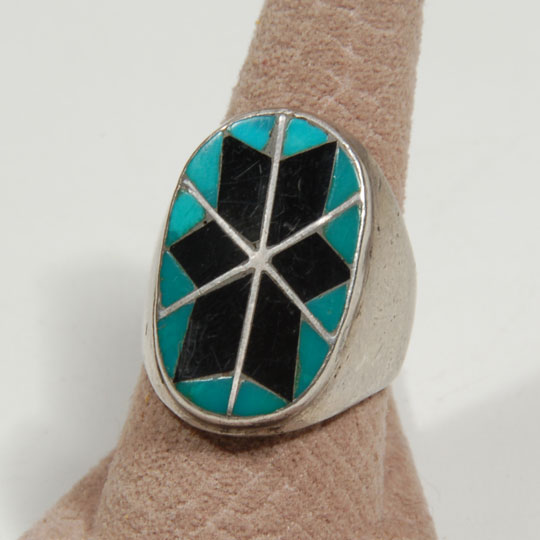 The first Zuni silversmith, Lanyad, learned his trade from the Navajo smith Adsity Chon in 1872. After that time the Zuni combined their lapidary skills with delicate silver work to develop a distinctive jewelry style. The Zuni then specialized in setting stones into the newly discovered technique of silverwork. This exquisite ring is comprised of individual small cuts of turquoise and jet which then were joined stone-to-stone. The six stone-to-stone pieces were then inlayed between silver channels. The face of the ring is flat.
The first Zuni silversmith, Lanyad, learned his trade from the Navajo smith Adsity Chon in 1872. After that time the Zuni combined their lapidary skills with delicate silver work to develop a distinctive jewelry style. The Zuni then specialized in setting stones into the newly discovered technique of silverwork. This exquisite ring is comprised of individual small cuts of turquoise and jet which then were joined stone-to-stone. The six stone-to-stone pieces were then inlayed between silver channels. The face of the ring is flat.
Read more about this Zuni ring here.
Zuni Multi-Stone Inlay Rainbow Man Pin - C3750G
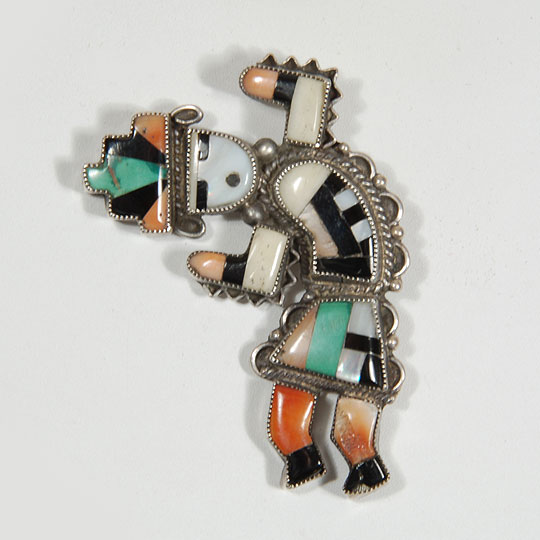 The Zuni Rainbow Man is among the most popular jewelry item for collectors. Representations of specific native religious imagery such as this was frowned upon among most pueblos, but some ceremonially significant figures were conventionalized and used for decorative purposes, probably knowingly so, because of non-Indian interest. Some of these figures had their appearances deliberately altered to avoid offending traditionalists' spiritual sensitivities.
The Zuni Rainbow Man is among the most popular jewelry item for collectors. Representations of specific native religious imagery such as this was frowned upon among most pueblos, but some ceremonially significant figures were conventionalized and used for decorative purposes, probably knowingly so, because of non-Indian interest. Some of these figures had their appearances deliberately altered to avoid offending traditionalists' spiritual sensitivities.
Read more about this pin here.
Zuni Silver and Turquoise Channel Inlay Ring by Frank Vasit - C3750P
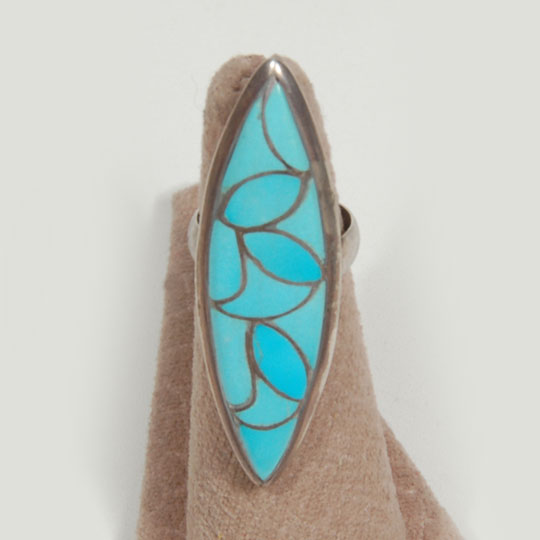 Zuni artisan Frank Vasik was active between 1930 and 1950 or a little later. He was married to the daughter of Leekya Deyuse, the most famous Zuni fetish carver of all times. His jewelry is in the collections of the Smithsonian National Museum of the American Indian and the Heard Museum in Phoenix.
Zuni artisan Frank Vasik was active between 1930 and 1950 or a little later. He was married to the daughter of Leekya Deyuse, the most famous Zuni fetish carver of all times. His jewelry is in the collections of the Smithsonian National Museum of the American Indian and the Heard Museum in Phoenix.
Read more about this ring here.
Diné – Navajo Silver and Turquoise Bola with Tips - 25639
The bola tie has become as much of a southwestern way of dress as cowboy boots and the ten-gallon hat. In fact, it is now by legislative decree the official neckwear of the state of Arizona. Victor E. Cedarstaff, of Wickenburg, Arizona, designed and handcrafted the first bola tie in the late 1940s.
Read more about this bola tie here..

